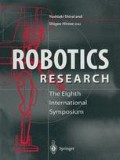Abstract
Artificial electrical stimulation is one of the tools of neuroethology to investigate and probe a living neural system. By applying artificial inputs to the system, specific reactions can be observed and a model or hypothesis of the inner workings can often be deduced. The escape turn of the American cockroach, Periplaneta Americana (L.), is a well-known fixed reaction pattern in response to the appearance of a predator. Video analysis is one method used to collect quantitative data on the locomotion behavior, but here we have built a trackball device to measure the locomotion behavior mechanically. The major advantage of this method is to obtain locomotion parameters (angle, distance) easily and instantaneously, and to keep the insect immobile for easy access of stimulation and monitoring.
We analyze the locomotory reaction of the Periplaneta Americana to various electrical stimuli. The insect is placed on a light-weight styro-foam trackball which is connected to a computer. This allows to record the turning rate and the forward movement of the insect in response to electric antennal stimulation. Based on this data a simple mathematical model is established.
Access this chapter
Tax calculation will be finalised at checkout
Purchases are for personal use only
Preview
Unable to display preview. Download preview PDF.
References
M. Burrows, “The Neurobiology of an Insect Brain,” Oxford University Press, 1996.
Y. Kuwana, I. Shimoyama, H. Miura, “Steering Control of a Mobile Robot Using Insect Antennae,” proceedings of the IEEE IROS’95 conference in Pittsburgh, 1995.
S. B. Crary, T. E. Moore, T. A. Conklin, F. Sukardi, D. E. Koditschek, “Insect Biobot: Electro-Neural Control of Cockroach Walking,” 1996 IEEE International Conference on Robotics and Automation, Workshop WT#, Bio-Mechatronics, Minneapolis, Minnesota, USA, pp. 42–54, April 22–28, 1996.
R. Holzer, I. Shimoyama, “Locomotion Control of a Bio-Robotic System via Electric Stimulation,” proceedings of the IEEE/RSJ Conference on Intelligent Robotics and Systems, IROS’97, Grenoble, France, 8–12 September, 1997.
C. M. Comer, J. P. Dowd, “Multisensory Processing for Movement: Antennal and Cercal Mediation of Escape Turning in the Cockroach,” in “Biological Neural Networks in Invertebrate Neuroethology and Robotics”, Academic Press Inc., 1993.
Author information
Authors and Affiliations
Editor information
Editors and Affiliations
Rights and permissions
Copyright information
© 1998 Springer-Verlag London Limited
About this paper
Cite this paper
Holzer, R., Shimoyama, I. (1998). Bio-robotic Systems Based on Insect Fixed Behavior by Artificial Stimulation. In: Shirai, Y., Hirose, S. (eds) Robotics Research. Springer, London. https://doi.org/10.1007/978-1-4471-1580-9_38
Download citation
DOI: https://doi.org/10.1007/978-1-4471-1580-9_38
Publisher Name: Springer, London
Print ISBN: 978-1-4471-1582-3
Online ISBN: 978-1-4471-1580-9
eBook Packages: Springer Book Archive

